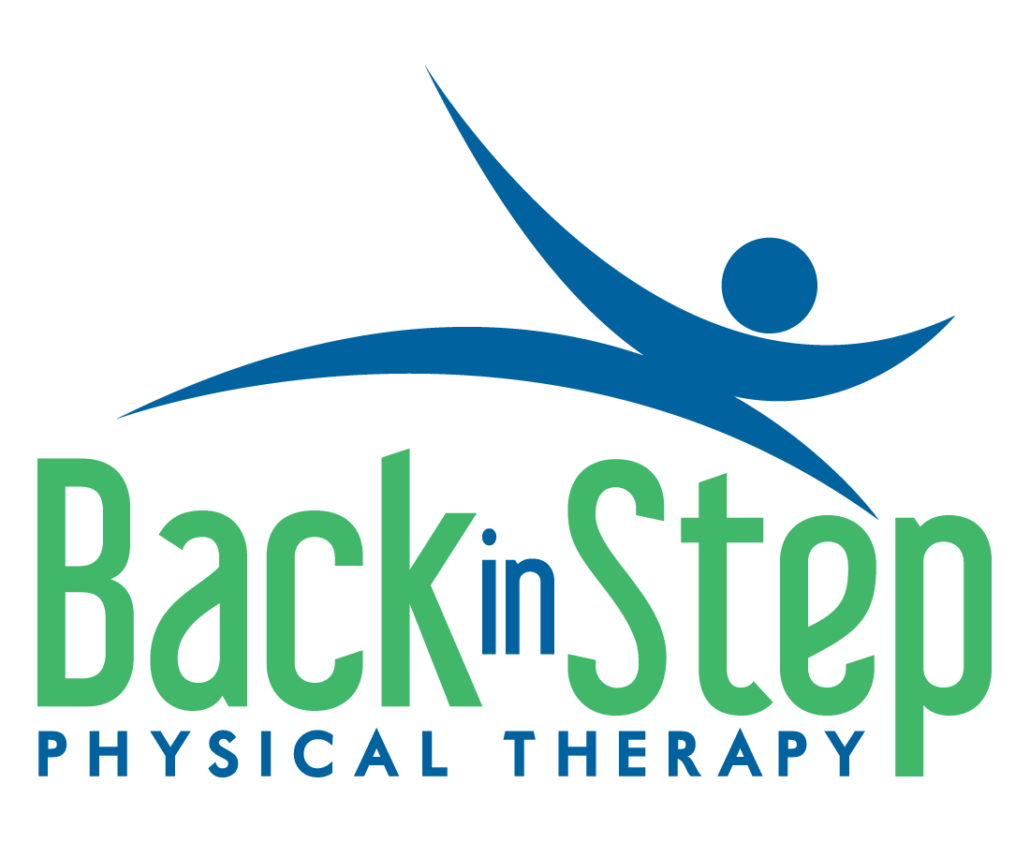Hypermobility & Dancers
/in Health & Wellness, The Performing Arts, Uncategorized /by Dr. Alyssa Arms, PT, DPT, OCSCNN recently published a wonderful article about hypermobility and, more specifically, a diagnosis called Ehlers Danlos Syndrome.
Hypermobility is something often seen in the dance community, and all too often, it’s undiagnosed.
What is hypermobility?
Generally speaking, hypermobility just means that the joint moves more than what is expected. This is completely normal for little kids, whose flexibility decreases as they get older.
But that’s expected. It’s when we’re seeing that beyond early childhood that we start to get more interested.
These individuals may be more flexibile, bendy, or say they’re double-jointed. People can be extra flexible and have no other symptoms. Others may have a list of things that go along with it.
Hypermobility in Adolescents & Adults
There are many different types of hypermobility, some of which have genetic component Some types have impacts like bone fragility (osteogenesis imperfecta) or changes in facial struction (stickler syndrome), for example.
Others have joint hypermobility as the main focus, but certainly not as the other symptom. These include categories like Hypermobility Spectrum Disorder, Joint Hypermobility Syndrome, and Hypermobile Ehlers-Danlos Syndrome.
For this group of diagnoses, hypermobility is just one piece of the puzzle. Often times, though, these individuals may expierence things like:
- Chronic fatigue
- Headaches
- Bruising easily or trouble healing wounds
- Stomach & digestive problems
- Bowel & bladder problems
- Autonomic dysfunction, including postural tachycardia syndrome (POTS), dizziness, fainting, etc.
- Mast cell activation syndrome (MCAS), which includes allergy-type symptoms
Many other symptoms or presentations may exist within the different types of hypermobility disorders, but the list above are some of the more common ones.
Hypermobility in Dancers
It can be challenging to identify some of our dancers with hypermobility, especially since dance is a sport & art form that often demands flexibility and is a big part of training.
These dancers may say that they work on stretching all the time but they still feel tight. They may also be a dancer who gets injured often or has health issues frequently.
Common injuries related to joint instability are be hyper-extension sprains or strains, joint subluxations or dislocations.
These may also be the dancers that have trouble with coordination or certain technique. With unstable joints, it’s harder to get good information from their proprioceptive system – the one that tells our brain where each part of our body is in space. That lack of good information means the dancer isn’t aware of how pointed their foot is or have trouble balancing, for example.
A dancer with hypermobility (diagnosed or not) may have their dance careers impacted by the joint instability or other symptoms. It is helpful to get the diagnosis and the support to help manage it.
Common Challenges
Hypermobility disorders, especially ones like Ehlers-Danlos (EDS), often go way too long without a diagnosis. It’s all too common to hear stories about people getting diagnosed in their 40s or 50s, seeing doctors for years for the various symptoms, and experiencing so much frustration.
With some of these diagnoses, other life-affecting problems abound, like gut issues, allergy-like symptoms, anxiety & other mental health issues – the list goes on.
According to the Ehlers-Danlos Society, the average time to diagnosis can be 10-12 years. One study also showed that 20% of EDS patients have seen more than 20 doctors while trying to get a diagnosis.
Why this is important
Although there currently is no cure for EDS or other hypermobility disorders, there are things that can be done to support those with the diagnosis.
There are a growing number of resources available to help, including specialists who focus in this area. These specialists can help with supportive nutrition plans, ways to work on physical health while maintaining joint safety, and so much more.
At Back in Step PT, we’ve seen many cases of young dancers with suspected or diagnosed hypermobility disorders. We’re hear to support you and help you get some answers.
Work Life Balance and Work from Home
/in Health & Wellness, Uncategorized /by Dr. Alyssa Arms, PT, DPT, OCSAs workdays shifted to our homes, our personal and work lives intertwine and surround identical key environments. After heading to the same kitchen table for our nine to five and midnight snacking, home can no longer feel like home. The line between these different worlds blur and the struggles of living in a pandemic are always knocking.
Days feel repetitive, work is overwhelming, and feeling like you’re in a rut is common occurrence for many employees nowadays.
Why is Work Life Balance Important?
It was reported that “66% of full-time employees in the U.S. do not strongly believe they have work-life balance.”1 Not only are workers feeling tired, but 190 billion dollars per year is spent on addressing the psychological and physical effects of burnout2. This means that working individuals are struggling to find a healthy work-life balance and the effects can be significant.
One of the main concerns of struggling with a work-life balance is the impact on physical and mental health. As physical and mental health coincide, it’s important to remember how these both work to affect our general wellness.
The Effects of Lack of Balance
For example, your boss has been making you work overtime to complete a project with a strict deadline. In order to finish the project, you’ve been staying up later and cutting your hours of sleep. Suddenly, you start to wake up with an aching back and an aggravating headache that coffee can’t seem to fix.
Even though the causes can vary, it is important to keep in mind that sudden influxes of stress and change can cause serious health implications. If you’re constantly stressed, physical symptoms can arise such as “headaches, upset stomach, high blood pressure, chest pain, and problems with sex and sleep”3. Therefore, it is necessary to understand the long-term effects that arise from your lack of health, and we want to minimize these impacts as soon as possible.
And yes of course, working from home can make you more productive, flexible with your own schedule, and has other benefits. However, if you aren’t experiencing many positives, keep in mind that adjusting to a new work life and the consequences of isolation is tough.
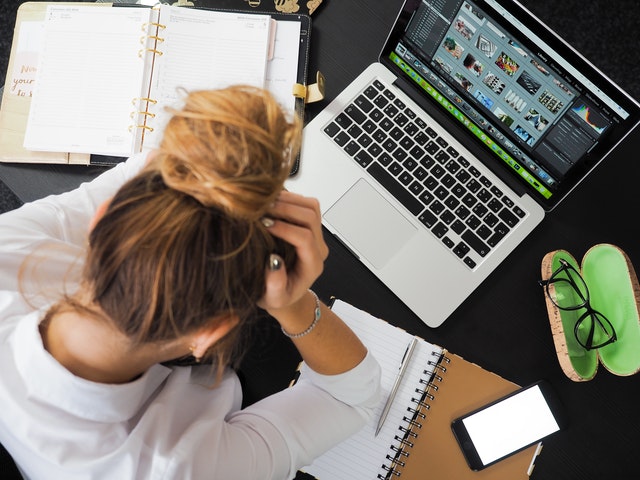
Thus, if you’ve been feeling burnout or stressed, here are ways to create a better work-life balance.
Create A Workspace
Before the pandemic, most of us had a designated workspace such as an office or cubicle, with immediate access to printers, high-end computers, and quick coffee machines. Because the switch to remote work was so swift, many of us didn’t have the time to personalize our workspaces.
Having an appropriate workspace is necessary for forming a balance between work time and free time. Whether it’s the corner of your dining room to the side of your bedroom, make sure your workspace can create boundaries. So, from 8:30 a.m. to 4:30 p.m. you are in one part of your home, and from 4:30 p.m. after, you’re spending time in other spaces of your home. This can help you feel like work and your home life are different realms.
For more information on how to upgrade your workspace, take a look at our extensive work from home toolkit with affordable options to make your workspace more comfortable.
Form A Routine
Routines can be helpful in times of uncertainty and stress. So, form a structured routine that can give you a sense of control. Remember to incorporate a sleeping schedule, an eating routine, and time for fitness to ensure you are prioritizing all of your needs. Keep in mind, flexibility is key and every day is different. Your routine may need to change to accomodate things that come up and that’s ok!
Communicate With Your Employer
Your employer knows COVID-19 has changed how their employees’ work. Whether the amount of work has increased, or you feel overwhelmed, remember that your needs are important. Contact your supervisor and discuss changes that could be helpful for both of you.
It is also important to check your employee guidelines and handbooks to see what options you have through your company, whether it’s things like workers compensation for injury, corporate wellness programs, and more.

Connect With Friends And Co-workers
Because work environments had active communication and our personal lives had plenty of social interaction, make sure you take time to connect with co-workers and friends. Reach out to a colleague or friend that you haven’t been able to see and plan a quick zoom lunch or an outdoor coffee meet-up. This way, you can take a breather and also see how others in your company/life are dealing with the pandemic.
Most importantly, you don’t need to be perfect!
It is important to understand that creating a work-life balance can be particularly hard when work AND personal life are at home. Self-care and forming a routine that suits you is the ultimate way to ensure you are meeting your best health.
If there are moments where you forget to take time for personal care, find ways to make sure that you prioritize yourself.
- Set reminders on your phone.
- Ask your significant other to keep you in check.
- Strict cut offs when your workday is done.
WANT MORE?
We are always happy to work with employees and reaching their ultimate health and wellness. If you are dealing with physical pains or issues, consider reaching out for professional help. We offer things like:
- On-site wellness services,
- Ergonomic assessments,
- On-site first aid, and
- Physical therapy for work injuries.
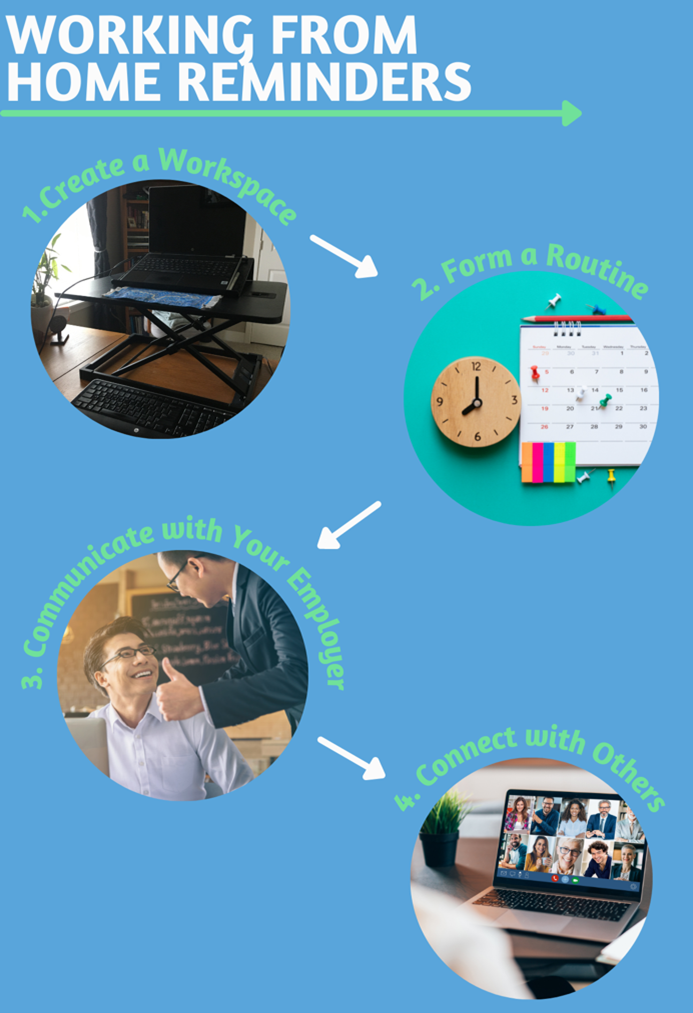
Guest Blog
Afraa Waheed is a third-year student at the University of Illinois at Chicago studying public health, psychology, and disability and health development. She is a passionate advocate for health equity and believes in providing the best care services to all communities. Afraa currently works as an intern for Back in Step Physical Therapy.
References:
Back in Step with Steady Nutrition
/in Corporate Wellness, Health & Wellness, The Performing Arts, Uncategorized /by Dr. Alyssa Arms, PT, DPT, OCS“Eat less. Eat more. Cut carbs. Add fats. Take away fats. Crash diet. Water weight. Hydrate. Substituting. Try dark chocolate. Pile on the veggies!”
 Many of us have heard these words and phrases thrown around when it comes to nutrition. I don’t know about you guys, but all of the conflicting information found online can be really confusing to navigate. There are so many people advocating for fad diets and quick fix solutions on social media, but what do you try and what will really work for you in the long run? How do you find the right way to adjust your lifestyle to consistently maximize nutrition, lose weight, add muscle, sleep better, increase energy and performance, and just feel healthier?
Many of us have heard these words and phrases thrown around when it comes to nutrition. I don’t know about you guys, but all of the conflicting information found online can be really confusing to navigate. There are so many people advocating for fad diets and quick fix solutions on social media, but what do you try and what will really work for you in the long run? How do you find the right way to adjust your lifestyle to consistently maximize nutrition, lose weight, add muscle, sleep better, increase energy and performance, and just feel healthier?
Lets explore some of these topics by addressing what nutrition is and how to consistently get it.
Nutrition: What is it?
Take a second and think about what you know about healthy food choices. What comes to your mind regarding the word nutrition?
Did you picture broccoli and kale? Or apples and grapes? Or maybe memory came up about “healthy dieting”? You probably have a lot of knowledge about what is healthy and what is not. You know your body and what helps you have energy and what makes you feel slow. Or maybe you’ve even grown-up with parents expressing that fruits and vegetables are good, and that sugar and fried food are bad. Let’s keep expanding this idea by diving into the details of nutrition.
Nutrition is simply “the process of obtaining food that is necessary for health and growth.” It is the intake of food that nourishes your body and mind. This process can seem confusing if we don’t even know where to start or what food are good for your body.
Essential Foods for a Healthy Body
Here is a list of 6 food types that are essential to nourish your body and help keep you healthy. Explore these items the next time you are at the grocery store. Maybe even try adding in a few of these examples for a nutritious, balanced plate.
- Vegetables and fruits.

You guessed it. Veggies and fruits are super nutritious foods that contain a lot of natural vitamins
to help your body function, grow, and work to its best ability. There are 13 vitamins are considered essential nutrients that we can only get from eating food, and many of them are found specifically in veggies and fruits. These guys are also high in fiber, which helps keep your gut from getting blocked up and bloated. By incorporating fruits and veggies, you may reduce inflammation in your body, which could even decrease chronic pain levels!
A few good rules of thumb to keep in mind:

-
- Different colors of fruits and vegetables contain different vitamins. Try for a variety of colors to eat to get all 13 essential vitamins.
- Shoot for dark leafy greens and fruits that are colorful on the inside. They carry more than one vitamin.
- Work toward adding in 5 portions of fruits and veggies a day.
- Consider adding a multivitamin to your diet in the beginning as you are getting used to this new addition. (Consult with your primary care physician to find out if this is a good option for you).
- Healthy Fats.

Yeah, you need fats for body to work well. Your brain functions best with healthy fats because they
help with making your nerve pathways faster. Your body also needs them to absorb minerals and vitamins A, D, E and K (4 out of the 13 essential nutrient vitamins). Fats also make up a large portion of your cells and are important for new cell growth (for healthy skin and nails), blood clotting for when you have an injury, and they supply energy for sustained muscle movement.
Some ideas for healthy fats are “omega-3 and omega-6 fatty acids” found in chia seeds, nuts, fish, and olive oil. Try to limit unhealthy trans or hydrogenated fats like butter, processed peanut butter, fatty red meat (burgers and pork) and processed soft cheeses.
- Essential minerals.
These are nutrients you get from food like calcium, iron, phosphorus, potassium, sodium, and magnesium. Minerals are important to help your bones grow and allow for your brain to work fast and efficiently to form thoughts. They also help with muscle control, nerve action, and heart and organ health.
You can get these essential minerals by eating fish, a variety of dark vegetables and colorful fruits, beans, seeds, nuts, fish, and grains like rice and cereals.
- Proteins.

Proteins are wonderful nutrients for building muscle and for helping your hair, skin, nails
, and bones. They are made up of “essential amino acids” which are the building blocks of proteins. You need to get all of these amino acids for your body to grow muscles and to repair itself after work outs.
Animal meat contains all essential amino acids. Try for lean meat to control healthy fat intake. Examples of healthy meat include eggs, fish, chicken breast, and lean steak.
You can also get protein and essential amnio acids with eating a combination of plant sources like whole grains, nuts, legumes, and vegetables.
- Carbohydrates.

Yes! Carbohydrates are essential for proper nutrition! Good carbs supply your brain and body with momentum throughout the day. They are the nutrient that burns the fastest to supply you with energy, and they are especially important for fueling your working out and homework brain power. However, don’t go eating that donut quite yet. Carbohydrates that are also full of fiber and have high water content will supply you with immediate energy and also help you feel full longer.
Fruits are a great source of carbohydrates due to their sugar content. Many of them also have fiber which helps you feel satisfied and less hungry for longer bouts of time. Oats, quinoa, and whole grains are also great sources of carbohydrates that supply energy and keep you full.
- Water.

Last, but certainly not least, is water! Hydration is vital for a healthy body, after all, we are made up of roughly 60% water. Dehydration can lead to cramps, nausea, lightheadedness, fainting, and poor performance with athletic activities.
Daily recommendations is to drink half of your body weight in ounces. This means if you weigh 200 pounds, you need to drink 100 ounces of water every day. You can track this with easy and free apps on your phone like: Plant Nanny, My Water Balance, or Daily Water Tracker.
With athletic activity, shoot for drinking 15-20 ounces of water 1-2 hours before you start exercising. Make sure to stay hydrated while you exercise by drinking 8 ounces of water every 15 minutes (it helps with regulating your temperature during activity). Be sure to avoid carbohydrate drinks and large amounts of sugary fruit juice, because these can be counterproductive. At the end of working out, replenish all of the liquid you lost through sweat by drinking at least 8 to 10 ounces of water within 30 minutes after activity.
Check out our Back in Step PT Pinterest for some healthy recipe ideas by Dr. Alyssa Arms, DPT.
Consistency for Long Term Results
You now know all of this information about nutrition. You know what you “should” add into your daily meals. Now what?
The matter of fact is that consistency is difficult to achieve, especially when forming new dietary habits. It also looks different for everyone. What worked for your friend or family member may not work for you. So let’s take a deeper dive into your individual life and explore some factors to help you get started with consistency when it comes to getting proper nutrition.
First off, I would like to take a moment and thank you for showing up for yourself. If you are on this page, it means you are putting your health and nutrition first. It means there is a part of you that may be willing to make a step toward change.
Thoughts to Consider
I want to encourage you to take a moment to reflect on your relationship with food and nutrition and write down your thoughts to these questions:
- What is your goal for your health related to nutrition?
- Do you have any concerns about accomplishing your goal?
- Which concern is the most important and why?
- What do you want to change?
- How do you specifically want your eating habits to be different?
- What has worked for you in the past?
- What has not worked and what did you learn?
- Has there been anything to block you from your goal in the past?
- Why is it important to make a change now?
- How are you ready, willing, and able to change your nutrition habits?
After thinking through these questions, take this moment to come up with one thing than you can add into your daily routine to help you with nutrition. Actually take time right now to think through this.
Choose One Thing
What is that one thing you can do that you are already sort of good at doing anyways? Start small. What is realistic with your work schedule, life responsibilities, and finances? Is it something you can do everyday for 2 weeks in a row? Can you start today?
Here are some examples to consider:
-
- Do you classify yourself as a “picky eater”? No worries! Just start with adding more water and taking multivitamin everyday.
- Maybe you have some of the nutrients we talked about in your diet already, but eat irregularly and only when you feel like it. Or maybe you eat when you’re sad, bored, or have something on your mind. Try adding a food log. Journal your food and water intake throughout the day to draw attention to when you eat and what you are eating. Start small with just gaining awareness.
- What if you are good at making a consistent breakfast of eggs and toast. Can you add in a big glass of water and a fruit? Try to make one meal a day consistent with nutrients over the next two weeks.
- Maybe try adding in one new fruit and one new vegetable this week. Google an interesting way to prepare the new food item and give it a shot!
- What if you don’t have time to cook? That’s fine. Consider investing in a slow cooker Crock Pot to make your meal in the morning so that it is ready at the end of the day. Or maybe sign up for a meal delivery kit that has the ingredients and recipes picked out for you already.
- Maybe you are a “snacker” (I know I am). Something that has helped me is prepping fruits, veggies, and healthy granola bars to have in my backpack so that I avoid the temptation of fast-food.
Small Habits for Big Results
The key to making a long-term change in nutritional habit is to build up little skills that are related to your goal. By starting with something small and easily doable with your life routine, you can make changes to implement the big goal for the long run.
Remember that there is no failure, only feedback. If your one habit is not consistently working for you, change it up! Focus on a habit to reflect your strengths of what you are already doing well. See if your friend or family member would be willing to check in with you every week to keep you accountable to your habit. If you choose to start with logging your daily food choices or energy levels, you can track your progress overtime as you slowly implement a new habit every 2 weeks to work toward your goal. Be sure to celebrate your successes as you go 😊
So, where do you see yourself going from here?
Next Steps
Thank you for taking this information and self-assessment journey toward improving your nutritional habits. We talked about the essential nutrients of vitamins, minerals, fats, proteins, carbohydrates, and water. We’ve given you some food examples to try and a plan for starting your consistency of nutritional habits. Chose one thing to work on over the next two weeks to approach your healthy food goal.
You are strong, capable, and have just taken the first step toward your goal by reading this today.
If you have any questions, or would like to talk with somebody about a more individualized plan toward health, fitness, nutrition, or physical activity, Back in Step Physical Therapy is here for you! Please contact Back in Step PT to schedule an online or in-person consultation today. Make sure to check out our other blogs and follow us on Instagram and for additional tips and tricks from Dr. Alyssa Arms, DPT.
Guest Blog by Haley Tirado, SPT
Haley Tirado is a second year Student Physical Therapist who attends the University of Colorado Anschutz Medical Campus. She completed a work study focused on physical therapy reasearch with the medically complex and total joint replacement patient populations. Haley currently works as an intern for Back in Step Physical Therapy.
Resources
Nutrition and Physical Therapy: A Powerful Combination
Precision Nutrition- Nutrition Coaching Course
How to do Motivational Interviewing: A guidebook
Healthy Ways for Working from Home: Fitness
/in Corporate Wellness, Exercise Ideas, Health & Wellness, Uncategorized /by Dr. Alyssa Arms, PT, DPT, OCS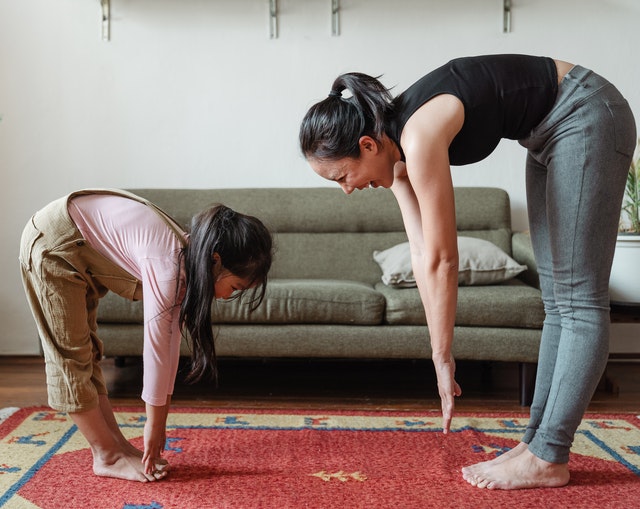 Welcome back to our blog series focused on healthy ways for working from home! We’ve explored many topics together so far, from posture and desk set up, to rejuvenating break ideas for the body and mind. Feel free to check out blog one and two for helpful tips and tricks on reducing muscle pain and increasing focus while working from home. Today we’ll discuss preventing discomfort and enhancing concentration through establishing an easy foundation for fitness at home.
Welcome back to our blog series focused on healthy ways for working from home! We’ve explored many topics together so far, from posture and desk set up, to rejuvenating break ideas for the body and mind. Feel free to check out blog one and two for helpful tips and tricks on reducing muscle pain and increasing focus while working from home. Today we’ll discuss preventing discomfort and enhancing concentration through establishing an easy foundation for fitness at home.
Fitness
Fitness? More like fit-ness whole pizza in my mouth.
Yeah, we have all heard the word fitness and have felt convicted to exercise, but are often confused on how to approach doing so, especially while being stuck at home. The gyms nearby may be closed, or possibly inaccessible due to work schedules conflicting with limited business hours. You could go on a walk or a jog outside, but the weather may not allow for it.
So why even try when it doesn’t seem to line up for you?
Know that you are not alone. A recent international survey indicates that despite the recommendations to stay physically active, there has been a significant decline in exercise levels during the “stay at home” period of COVID-19. Globally, people are sitting a lot, eating extra-frequently, and consuming more unhealthy food compared to before the pandemic (nothing like mac and cheese to pep up a boring afternoon). We are all in this struggle together, and we need to fight to decrease inactive behavior, promote health, and further our fitness.
Its Effect on Whole-Body Health
Studies on fitness show that physical activity can improve your health and fight against the negative effects of diabetes, heart disease, and high blood pressure. Exercise also improves mental health, which many of us are struggling with due to social isolation. It is important to boost your fitness for optimal brain power and for bettering thought processes while working from home.
Your body is composed of several muscle groups that contribute to your functioning while you work. You may not notice it, but there are a lot of muscles working to help your body sit and stand with good posture. By adding in physical activity and exercise into your daily at-home routine, you can build up muscle strength and endurance to counter the painful effects of prolonged bad posture while working from home. It’ll also improve the blood flow to your brain to help your concentration!
Fitness = Physical Activity + Exercise
For our purposes, we’ll discuss two different parts of fitness: physical activity and exercise. Physical activity is when we use several large muscle groups to move the body around at moderate to high intensities. This can include hobbies like dancing or even heavy household chores, like vacuuming or mowing the yard. Exercise, on the other hand, is the strengthening of more specific muscle groups in the body. Examples may include different exercises you see at the gym and/or running for building up your heart muscle. Keep reading for some guidelines on physical activity and ideas for exercises at home!
Physical Activity Recommendations
When in doubt, move more and sit less! Start small if you need to. Feel free to get creative with your fitness and find things that you like to do at home that keep you on your feet. I personally enjoy doing yoga and completing household projects, like organizing and decorating. According to an article on fitness from Public Health Reports, physical activity should be performed every day, or at least every other day, to increase your health.
Here are the recommendations on weekly physical activity based on age:
Children age 6 to 17
Kids and teens need at least 60 minutes a day of moderate to vigorous activity. This should include 3 days of strengthening exercises to help with muscle and bone growth (read more below for ideas on how to strengthen from home.)
Adults age 18 to 65
Adults need 30 minutes of moderate intensity activity 5 days per week, or 20 minutes of vigorous activity 3 days a week. This can also be in a combination or moderate and vigorous intensity throughout the week. The 30-minute daily total of moderate intensity can also be achieved in small bouts of 10-minute continuous activity.
How do you find out what is moderate versus high intensity for you? Check out our YouTube video!
Fitness Through Exercise
Now how do you actually build muscle from home without a gym? This is your opportunity to think outside of the box with items around your house and get creative with your fitness. Here are some ideas to try based on strength, endurance, and cardiovascular fitness.
Muscle Strength
Your muscles are made up of different types of muscle fibers. Strengthening specifically focuses of building your “fast-twitch” fibers for fast muscle power. We use these muscle fibers to perform many of the typical gym exercises that one might think of. The goal for strengthening is to only be able to complete 8 to 12 repetitions of an exercise before you’re tired and your form is messed up.
Try this exercise for strong arms:
-
-
- To strengthen your arms with biceps curls, you’ll want to find a bag of books in your house that is heavy enough to challenge you.
- Stand in front of a mirror and complete 8-12 reps of slow and controlled biceps curls. If you can go onto 13 reps without a challenge, then add more books.
- If you can only do 8-12 reps before you notice that you body starts trying to fatigue and compensate elsewhere (your shoulder hikes up or your posture starts leaning), then that is your maximum.
- Once you find your max, take a rest break, and try for another set.
- Keep completing sets of your 8-12 reps until you notice you cannot do them anymore because of losing form due to muscle fatigue setting in.
-
Muscle Endurance
To build up fitness through muscle endurance, you’ll want to challenge the “slow-twitch” muscle fibers. This is so that your muscles don’t get tired while you do things like repetitive motions, holding still postures, and walking further distances. Many strengthening exercises can be turned into muscle endurance exercises by changing how many times you do the exercise! It all depends on your fitness goal and what you need to be able to do in your everyday life. The idea of muscle endurance is to be able to do 15-20 repetitions of an exercise before you’re tired and your form gets messed up.
Try this exercise for leg muscle endurance:
-
-
- To strengthen your leg muscle endurance, you’ll want to find a mirror to stand in front of while you do squats.
- You should be able to do 15 to 20 repetitions before you notice your form starting to compensate (your trunk leans to one side, your knees go forward or move together, or your back starts to arch).
- You can make squats easier by using a chair to sit and then stand, or more difficult by holding a book to your chest to add some weight.
- Once you find your max of 15-20 reps, take a rest break, and try for another set.
- Keep completing sets of your 15-20 reps until you notice you cannot do them anymore because of your form messing up due to muscle fatigue setting in.
-
Cardiovascular Fitness
 Cardiovascular fitness is the strengthening of your heart to improve blood flow to your muscles. If your heart is pumping blood efficiently, the muscles that hold your body upright while sitting will get enough oxygen and may not get tired as easily while you work from home. The workday may feel less fatiguing when your brain is getting enough nutrients from a healthy beating heart. Great blood flow also helps your working muscles to fight against exhaustion while exercising!
Cardiovascular fitness is the strengthening of your heart to improve blood flow to your muscles. If your heart is pumping blood efficiently, the muscles that hold your body upright while sitting will get enough oxygen and may not get tired as easily while you work from home. The workday may feel less fatiguing when your brain is getting enough nutrients from a healthy beating heart. Great blood flow also helps your working muscles to fight against exhaustion while exercising!
To get your heart to build up strength and endurance, your lungs will have to work harder. You may feel out of breath at first, but this is normal! Increasing your pulse rate during cardiovascular exercise means that your heart muscle needs more oxygen from your lungs.
Simply put: as your heart beats faster, you will breath harder, challenging the lungs and chest muscles. Breathing will become easier as you strengthen this system by doing moderate to vigorous exercise.
Here are some ideas cardiovascular exercise at home:
-
-
- Walking longer distances at an increased pace
- Jogging or running outside
- Go for a bike ride
- Swimming if you have access to a pool
- Dancing around the house (by yourself or with a friend)
- Shooting hoops (with a mask on)
- Jumping rope
-
Check out our YouTube videos on exercises to try at home for different muscle groups:
Upper and Lower Back Exercises
Bringing It All Together: Healthy Ways for Working from Home
You made it through the three-part blog journey. Congratulations! We’ve addressed several tips and tricks to help your body stay rejuvenated and pain free while working from home. You have found your best seated posture and sprinkled your workday with rejuvenating mind and body breaks. With a guideline for physical activity and several exercises to try at home, you’re now ready to conquer daily tasks with improved concentration and decreased pain. We’d love to help you with a more tailored and individual approach if you have further questions about healthy ways for working from home. Please contact Back in Step PT to schedule an online or in-person consultation today! Make sure to check out our other blogs and follow us on Instagram and Facebook for additional tips and tricks from Dr. Alyssa Arms, DPT.
Check out our Work from Home Kit!
Guest Blog by Haley Tirado, SPT
Haley Tirado is a second year Student Physical Therapist who attends the University of Colorado Anschutz Medical Campus. She completed a work study focused on physical therapy research with the medically complex and total joint replacement patient populations. Haley currently works as an intern for Back in Step Physical Therapy.
Article References
- Effects of COVID-19 Home Confinement on Eating Behaviour and Physical Activity: Results of the ECLB-COVID19 International Online Survey
- Physical exercise as therapy to fight against the mental and physical consequences of COVID-19 quarantine: Special focus in older people
- Health Benefits of Exercise
- Physical activity and exercise to achieve health-related physical fitness components.
- World Health Organization
- Physical activity and coronavirus disease 2019 (COVID-19): Specific recommendations for home-based physical training
Healthy Ways for Working from Home: Breaks
/in Corporate Wellness, Health & Wellness, Uncategorized /by Dr. Alyssa Arms, PT, DPT, OCSPart 1 of this three-part series focused on setting up an ergonomic office space built around your unique best posture while working from home. Check out this post here for healthy tips on workspace set up and intentional movements to try while you work. This next part of this series will focus on practical and healthy ways to minimize pain by incorporating breaks throughout your workday.
Take Breaks
Before the pandemic and the shift to working from home, you may have had mandatory breaks incorporated into your workday. Now that you’re in charge of scheduling, it may be tempting to power through work duties without breaks, but this can lead to body discomfort and burn out.
As a grad student, I’ll be the first to admit that it’s difficult to take active and healthy breaks while I am in the middle of online classes and assignments. I typically find myself crawling over to the couch to lay down and stretch my back while I indulge in an episode of my favorite TV show. I don’t know about you, but I never feel truly pain free, refreshed, or motivated to get back to work after a break like that. Let’s take a look at some ideas for rejuvenating breaks that will help your body and mind while working from home.
…For Your Body
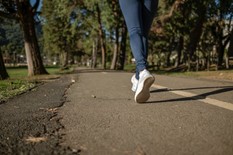 So, why take breaks? Studies show that sustained sitting can actually cause increased levels of pain, fatigue, and muscle stiffness in your back.1,2,3 Though the thought of taking breaks to move and change positions seems simple, it can be difficult to do without an environmental cue to remind you. Naturally occurring breaks could have looked like visiting a friend at a different desk, walking further to the restrooms, or maybe grabbing a cup of coffee on your way to fax a document. Now that you are working from home, start thinking of some ideas to incorporate these natural actions into your day. A great trick is to adapt your environment and add in some tasks that require you to get moving!
So, why take breaks? Studies show that sustained sitting can actually cause increased levels of pain, fatigue, and muscle stiffness in your back.1,2,3 Though the thought of taking breaks to move and change positions seems simple, it can be difficult to do without an environmental cue to remind you. Naturally occurring breaks could have looked like visiting a friend at a different desk, walking further to the restrooms, or maybe grabbing a cup of coffee on your way to fax a document. Now that you are working from home, start thinking of some ideas to incorporate these natural actions into your day. A great trick is to adapt your environment and add in some tasks that require you to get moving!
A randomized controlled trail study in 2018 looked at the actual plausibility of taking active breaks during the 8-hour day for a group of office workers.1 The article concluded that people were more successful adding in movement if it was related to a specific job task. For example, people used phone calls as a reminder to stand up. They were also more likely to take breaks for walking if it could be incorporated into their daily routine, like going to the fax machine, printer, or even the restroom. Internal cueing (listening to the body) was another trick that these office workers used to remind themselves take breaks to stretch and move.
Experiment!
How could you set up your home office to encourage breaks for walking? What cues could you use to remind you to stand up more and sit less? One idea is to use your lunch break for a walk around the neighborhood or do a little yoga session!
Muscle Rolling
An additional idea for a body break is to incorporate some stretching and muscle rolling movements during your lunch or 15-minute breaks. Muscle rolling is a great way to self-massage your spine and trap muscles, which typically get stiff and uncomfortable during lengthy bouts of working. A recently published article by Kett et al2 supports muscle rolling breaks to manage painful effects of sustained sitting.
 They found that 8 minutes of muscle rolling with a ball or bar was effective at improving symptoms in the back. This is because a slumped posture can cause muscle pain by increasing tone (contraction state) of muscles.2 The stiffness is caused by the tissue itself due to micro trauma of the stretched-out ligaments, disks, and capsules combined with muscle spasms that restrict blood flow.2 The muscle roller helps by breaking up the connections between stiff muscle cells, allowing for increased temperature to bring blood flow back into the spastic muscle. This technique can be used as one of your short active breaks to decrease muscle stiffness and promote relaxation!
They found that 8 minutes of muscle rolling with a ball or bar was effective at improving symptoms in the back. This is because a slumped posture can cause muscle pain by increasing tone (contraction state) of muscles.2 The stiffness is caused by the tissue itself due to micro trauma of the stretched-out ligaments, disks, and capsules combined with muscle spasms that restrict blood flow.2 The muscle roller helps by breaking up the connections between stiff muscle cells, allowing for increased temperature to bring blood flow back into the spastic muscle. This technique can be used as one of your short active breaks to decrease muscle stiffness and promote relaxation!
Check out our YouTube videos for how to muscle roll with a foam roller:
…For Your Mind



Intuition and uncomfortable body signals may indicate to us to stand up or move around, but mind breaks are just as important as body breaks. A beneficial place to start is to find out what you like to do that is peaceful and relaxing. For example, I enjoy playing my ukulele or calling a family member during my lunch break while working from home. Prioritizing psychosocial health is not only important for helping with the day, but it also plays a role in managing pain. A recently published article in 2020 looked at the relationship between chronic pain and depression levels.3 They concluded that managing your mind and social health can minimize depression, which actually has a significant effect lowering chronic neck and lower back pain and vice versa.
Here are some mindful ideas to try during your breaks:
- Check out our Work from Home Kit!
- Try some exercises for relaxation, stress release, and grounding. Check out our YouTube video on some techniques to try.
- Eat a healthy snack or create your favorite meal. Follow us on our Pinterest and Instagram for some of Dr. Alyssa’s favorite healthy recipes.
- Do something creative. Play your favorite music, dance like nobody is watching, or give painting a go!
- Prioritize your social health. Video chat a loved one or maybe even write a letter to someone you have been meaning to reach out to.
- For more ideas, please check out our blog on mindfulness here.
In our first blog we talked about ways to set up your home office to minimize joint pain and unnecessary muscle activation. We now have gone over some tips for healthy body and mind break ideas to minimize pain while you are working from home. Our next blog will focus on your overall health and overcoming health obstacles while working from home. If you have additional questions, Back in Step Physical Therapy is here for you! Please contact us to schedule an online or in-clinic consultation.
Follow our social media platforms for additional health tips:
Guest Blog by Haley Tirado, SPT
Haley Tirado is a second year Student Physical Therapist who attends the University of Colorado Anschutz Medical Campus. She is a student worker who participates in conducting physical therapy research studies with the RESTORE Research Team at UC Anschutz. Haley currently works as an intern for Back in Step Physical Therapy.
References:
1. Stephens SK, Eakin EG, Clark BK, Winker EAH, Owen N, LaMontagne AD, Moodie M, Lawler SP, Dunstan DW. What strategies do desk-based workers choose to reduce sitting time and how well do they work? Findings from a cluster randomised controlled trial. International Journal of Behavioral Nutrition and Physical Activity. 2018, 15:98. https://doi.org/10.1186/s12966-018-0731-z.
2. Kett AR & Sichting F. Sedentary behaviour at work increases muscle stiffness of the back: Why roller massage has potential as an active break intervention. Applied Ergonomics. Jan 2020, Vol 82: 102947. https://doi.org/10.1016/j.apergo.2019.102947.
3. Angst F, Benz T, Lehmann S, Wagner S, Simmen BR, Sandor PS, Gengenbacher M, Angst J. Extended overview of the longitudinal pain-depression association: A comparison of six cohorts treated for specific chronic pain conditions. Journal of Affective Disorders. 1 Aug 2020, Vol 273: 508-516. https://doi.org/10.1016/j.jad.2020.05.044.
Healthy Ways for Working from Home: Posture
/in Corporate Wellness, Health & Wellness, Uncategorized /by Dr. Alyssa Arms, PT, DPT, OCS
Working from Home
Nothing could have prepared us for the unprecedented times of a global pandemic. Many people are working from home for the first time and are having to manage daily stressors from an isolated environment. Personally, I have found it tricky to balance my work life, down time, and navigating my family’s needs all in the same small space every day! Out of all the challenges we face with this new socially distanced lifestyle, one stressor we shouldn’t have to worry about is pain caused by increased time on technology.
So how can you keep your body healthy and decrease muscle and joint pain while working from home during a pandemic?
Set yourself up for success.
Promoting health while working from home looks a little different for each person based on the availability of your surroundings. Some people are glad to have an office space while others have to get creative with tables and kitchen countertops.

Let’s start by taking a look at the designated working space that you have created at your home. It may be easy to dismiss this step in the rush of a busy morning routine, but once you have poured yourself a cup of coffee, take a moment to observe your work environment and its effect on your body. Set yourself up for success so that you can endure hours of work without feeling the negative effects on your arms, neck, or back.
It is important to build your work environment around your body’s best posture. Go ahead and take a moment to find your relaxed upright posture both while you are seated and while you are standing. According to an article in the Journal of Orthopedic Sports Physical Therapy, everyone’s “correct” posture will look different, and it is important to observe your own habitual posture and what it feels like to change it up.1
Check out this video to help you find your best posture: https://youtu.be/QJ7WRUGtziA
Once you are in your own unique upright posture, observe the height of your desk and chair. Refer to the image below for alignment ideas when tailoring your working environment to your body. Remember that everyone’s best relaxed posture varies. You may not sit exactly like the person in the image and that is OKAY! The purpose of this visual is to provide you with options for your legs, arms, head, and neck to be properly aligned with your desk and computer, and to minimize unnecessary compensatory muscle firing and uncomfortable pressures on your spinal column joints.
Experiment!

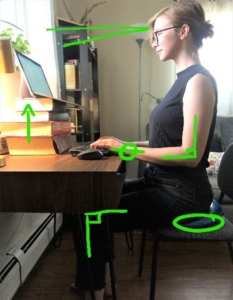
Try using books to prop up your laptop so that it is higher and closer to you. Having your laptop at eye level helps by placing less strain on your neck muscles and eyes. You might also consider getting a detachable keyboard and mouse and positioning them so that your wrists are straight and relaxed, your elbows are at 90-degrees, and your shoulders are in a comfortable resting position. Experiment with adjusting your chair by adding a pillow under your rear so that your hips and knees are at a 90-degree angle in your best seated posture. If you are using a high countertop, switch up your environment by standing rather than using a bar stool.
Perfect posture 100% of the time is unattainable, so remember that the most important thing is to set yourself up for success, tailored to your own upright, relaxed posture. According to the same article mentioned previously, movement is key to avoid pain in sustained sitting or standing.1 Change up your posture frequently and try adding in some intentional movements!
Here are some different exercises to try while you are working throughout the day: https://youtu.be/gAEoL7x1Ojg
Check in: Where are we at?
We have talked about ways to set up your home office to minimize joint pain and unnecessary muscle activation. Our next blog will bring some tips for healthy break ideas to minimize pain while you are working from home. If you have additional questions, Back in Step Physical Therapy is here for you! Please contact usContact to schedule an online or in-clinic consultation.
Follow our social media platforms for additional health tips: Facebook, Instagram
Check out our Work from Home Kit!
Guest Blog by Haley Tirado, SPT
Haley Tirado is a second year Student Physical Therapist who attends the University of Colorado Anschutz Medical Campus. She is a student worker who participates in conducting physical therapy research studies with the RESTORE Research Team at UC Anschutz. Haley currently works as an intern for Back in Step Physical Therapy.
References:
- Slater D, Korakakis V, O’Sullivan P, Nolan D, O’Sullivan K. “Sit up straight”: Time to re-evaluate. J Orthop Sports Phys Ther. 2019; 49(8):562-564. doi:10.2519/jospt.2019.0610. https://www.jospt.org/doi/pdf/10.2519/jospt.2019.0610
- Hein JT. Posture: Align yourself for good health. Mayo Clinic. Published December 14, 2016. https://www.mayoclinic.org/healthy-lifestyle/adult-health/in-depth/posture-align-yourself-for-good-health/art-20269950
ACL Injuries in Young Athletes
/in Health & Wellness, Uncategorized /by Dr. Alyssa Arms, PT, DPT, OCSWhen I was growing up, it was common for kids in my class to play different sports throughout the year. It was unusual to have someone who played year-round or played at multiple levels at once (like the school team plus club-level plus something else). You played your sport for that season, and then moved on to the next one when the time came. I don’t remember any of my friends dealing with things like ACL injuries or hip labral tears, for example.

Things are different now.
Kids, especially teens, are beginning to specialize in a sport at a much younger age and are practicing more intensely than was the norm in the past. Children are expected to choose their sport earlier and practice is no longer just a seasonal thing.
As a result, we are starting to see changes in the types of injuries that young athletes are dealing with. We are even noticing that certain injuries that were mostly seen in adults are now being seen in kids. We are even seeing injuries that used to be seen mostly in professional athletes!
This early specialization and more intense practice means that children are causing more repetitive stress and trauma to their bodies during a time that they are more vulnerable anyways. During puberty, the body is playing a game of catch-up. The bones are rapidly growing and changing, while the muscles, ligaments, and tendons are trying to keep up. At the same time, the brain and nervous system have to figure out how to coordinate and move the body that is ever changing.
One study found that risk patterns for injury differed for girls versus boys. Once the volume of training was accounted for, no one sport stood out as being more risky for girls. Any specialization for girls, however, increased the risk of injury by 30%. This was not true for boys – specialization in general was not problematic, but baseball, gymnastics, and cheerleading significantly increased their risk.

One type of injury that has shown a lot of change is ACL tears.
The ACL (anterior cruciate ligament) serves as one source of stability for the knee joint, connecting the femur (thigh bone) and tibia (shin bone).
Historically, teen girls have always had a higher risk of ACL injuries, but now we see that the rate of injury has been drastically climbing. Girls don’t develop power in the same way as boys during their growth periods. Besides that, differences in bony alignment between males and females also contribute to the risk of injury, as well as hormonal fluctuations.
Young athletes usually get ACL injuries through non-contact scenarios, like pivoting or landing from a jump. Some sports that may see this more often are soccer, tennis, volleyball, football, and skiing.
And these injuries are on the rise…
Here are some crazy statistics:
- According to an article in the Daily Mail, one clinic in Philadelphia has seen a 400% increase in ACL surgeries in teens over the past 10 years, and one clinic in Australia has seen a 148% increase during the same time frame.
- A group in Australia analyzed data on 320 children who were hospitalized for ACL injuries between 2005 and 2015.
- A whopping 96.9% of them were between the ages of 10 and 14 and more than half of them were boys.
- Sports activities accounted for 57% of the injuries, with 52% of the girls and 35% of the boys that were specifically playing ball sports.
- In total the rate of injury went from 2.74 injuries per 100,000 kids to 6.79 per 100,000!
Surgery is often the solution after experiencing a tear, especially if the athlete wants to continue playing in the future. Part of the problem with needing surgery after a tear is the risk that comes along with it. Physicians are often recommending to0 hold off on surgery as long as possible, in an attempt to let the bones continue growing and therefore preventing injury to the growth plate. And whether or not surgery is done, some evidence suggests that people may have a higher risk of developing osteoarthritis in that knee in the future.

So what’s the solution?
One thing that many experts agree on is changing up what the child is doing. Play more than one sport. Allow for breaks and changes in activity. Change it up to let muscles work differently. Even unstructured play can be helpful!
Make sure that all equipment is well fit and well maintained. This means ensuring proper fit of your student athlete’s shoes. They may be growing rapidly, but it’s worth getting new shoes when they need them, rather than waiting until they’re done growing, for example. Kids also need to use the proper equipment and make sure that it’s in good shape.
Be aware of the surfaces that the student is playing on. Artificial turf requires different responses from natural grass. A sprung floor provides less stress on the joints than traditional hardwood floors for dancers, but also requires a different technique for safe use.
Girls, in particular, also need more attention to make sure that their muscles are developing to appropriately support the ways they move in their sport of choice. Particularly for those in sports that require landing from jumps or pivoting and cutting need additional guidance.
Well-rounded training is also crucial. Kids’ programs should include prevention training, specifically neuromuscular training. Cross-training is important, as is working on balance and endurance. A fatigued athlete is always at a higher risk of injury.
And, most importantly, good ongoing communication between parents, coaches, trainers, and physical therapists play a large role in both prevention and recovery.

Need more info or have questions?
Contact us at Back in Step Physical Therapy to get scheduled for an evaluation. We want to keep your student athlete in peak condition to decrease their overall risk of injury, and, if they’ve already experienced injury, we want to help them return quickly and safely!
Back In Step Physical Therapy
6551 S Revere Pkwy, Ste 215
Centennial, CO 80111
(303) 960-2075
info@backinsteppt.com
